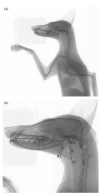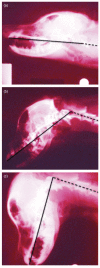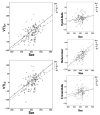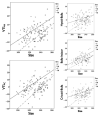Radiographic analysis of vocal tract length and its relation to overall body size in two canid species
- PMID: 24363497
- PMCID: PMC3866914
- DOI: 10.1111/jzo.12048
Radiographic analysis of vocal tract length and its relation to overall body size in two canid species
Abstract
Body size is an important determinant of resource and mate competition in many species. Competition is often mediated by conspicuous vocal displays, which may help to intimidate rivals and attract mates by providing honest cues to signaler size. Fitch proposed that vocal tract resonances (or formants) should provide particularly good, or honest, acoustic cues to signaler size because they are determined by the length of the vocal tract, which in turn, is hypothesized to scale reliably with overall body size. There is some empirical support for this hypothesis, but to date, many of the effects have been either mixed for males compared with females, weaker than expected in one or the other sex, or complicated by sampling issues. In this paper, we undertake a direct test of Fitch's hypothesis in two canid species using large samples that control for age- and sex-related variation. The samples involved radiographic images of 120 Portuguese water dogs Canis lupus familiaris and 121 Russian silver foxes Vulpes vulpes. Direct measurements were made of vocal tract length from X-ray images and compared against independent measures of body size. In adults of both species, and within both sexes, overall vocal tract length was strongly and significantly correlated with body size. Effects were strongest for the oral component of the vocal tract. By contrast, the length of the pharyngeal component was not as consistently related to body size. These outcomes are some of the clearest evidence to date in support of Fitch's hypothesis. At the same time, they highlight the potential for elements of both honest and deceptive body signaling to occur simultaneously via differential acoustic cues provided by the oral versus pharyngeal components of the vocal tract.
Keywords: animal communication; body size; vocal tract length.
Figures





Similar articles
-
Formants provide honest acoustic cues to body size in American alligators.Sci Rep. 2017 May 12;7(1):1816. doi: 10.1038/s41598-017-01948-1. Sci Rep. 2017. PMID: 28500350 Free PMC article.
-
Vocal tract length and acoustics of vocalization in the domestic dog (Canis familiaris).J Exp Biol. 1999 Oct;202(Pt 20):2859-67. doi: 10.1242/jeb.202.20.2859. J Exp Biol. 1999. PMID: 10504322
-
Honest signaling in domestic piglets (Sus scrofa domesticus): vocal allometry and the information content of grunt calls.J Exp Biol. 2016 Jun 15;219(Pt 12):1913-21. doi: 10.1242/jeb.138255. Epub 2016 Apr 8. J Exp Biol. 2016. PMID: 27059064 Free PMC article.
-
How small could a pup sound? The physical bases of signaling body size in harbor seals.Curr Zool. 2017 Aug;63(4):457-465. doi: 10.1093/cz/zox026. Epub 2017 Apr 12. Curr Zool. 2017. PMID: 29492005 Free PMC article.
-
Do age- and sex-related variations reliably reflect body size in non-human primate vocalizations? A review.Primates. 2007 Oct;48(4):253-67. doi: 10.1007/s10329-006-0033-y. Epub 2007 Jan 17. Primates. 2007. PMID: 17226064 Review.
Cited by
-
Evolutionary significance of the variation in acoustic communication of a cryptic nocturnal primate radiation (Microcebus spp.).Ecol Evol. 2020 Mar 12;10(8):3784-3797. doi: 10.1002/ece3.6177. eCollection 2020 Apr. Ecol Evol. 2020. PMID: 32313636 Free PMC article.
-
Individual distinctiveness across call types of the southern white rhinoceros (Ceratotherium simum simum).J Mammal. 2021 Mar 20;102(2):440-456. doi: 10.1093/jmammal/gyab007. eCollection 2021 Apr. J Mammal. 2021. PMID: 34121952 Free PMC article.
-
Head posture impacts mammalian hyoid position and suprahyoid muscle length: implication for swallowing biomechanics.Philos Trans R Soc Lond B Biol Sci. 2023 Dec 4;378(1891):20220552. doi: 10.1098/rstb.2022.0552. Epub 2023 Oct 16. Philos Trans R Soc Lond B Biol Sci. 2023. PMID: 37839446 Free PMC article.
-
Cranio-facial remodeling in domestic dogs is associated with changes in larynx position.J Anat. 2016 Jun;228(6):975-83. doi: 10.1111/joa.12452. Epub 2016 Feb 11. J Anat. 2016. PMID: 26863925 Free PMC article.
-
Vocal tract allometry in a mammalian vocal learner.J Exp Biol. 2022 Apr 15;225(8):jeb243766. doi: 10.1242/jeb.243766. Epub 2022 Apr 28. J Exp Biol. 2022. PMID: 35483405 Free PMC article.
References
-
- Charlton BD, Zhang Z, Snyder RJ. The information content of giant panda, Ailuropoda melanoleuca, bleats: acoustic cues to sex, age and size. Anim. Behav. 2009;78:893–898.
-
- Charlton BD, Ellis WAH, McKinnon AJ, Cowin GJ, Brumm J, Nilsson K, Fitch WT. Cues to body size in the formant spacing of koala (Phascolarctus cinereus) bellows: honesty in an exaggerated trait. J. Exp. Biol. 2011;214:3414–3422. - PubMed
-
- Chase K, Adler FR, Miller-Stebbings K, Lark KG. Teaching a new dog old tricks: identifying quantitative trait loci using lessons from plants. J. Hered. 1999;90:43–51. - PubMed
Grants and funding
LinkOut - more resources
Full Text Sources
Other Literature Sources
